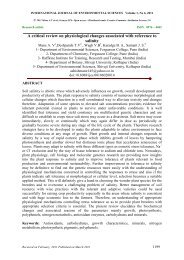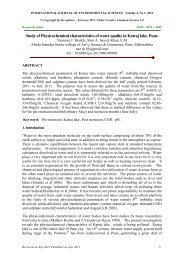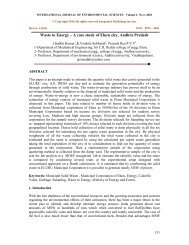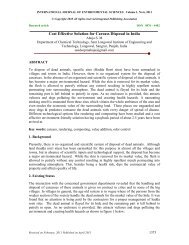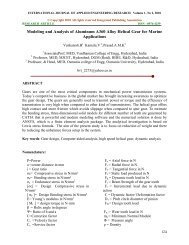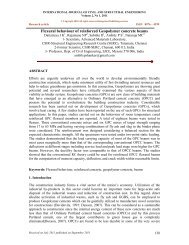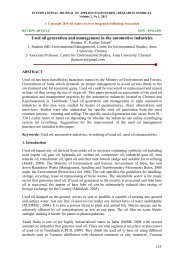Read full text - Integrated Publishing Association
Read full text - Integrated Publishing Association
Read full text - Integrated Publishing Association
You also want an ePaper? Increase the reach of your titles
YUMPU automatically turns print PDFs into web optimized ePapers that Google loves.
INTERNATIONAL JOURNAL OF ENVIRONMENTAL SCIENCES Volume 1, No 7, 2011<br />
© Copyright 2010 All rights reserved <strong>Integrated</strong> <strong>Publishing</strong> <strong>Association</strong><br />
Research article ISSN 0976 – 4402<br />
Synthesis of flow series of tributaries in Upper Betwa basin<br />
Chaube U.C 1 , Shakti Suryavanshi 1 , Lukman Nurzaman 2 , Ashish Pandey 1<br />
1 Department of Water Resources Development and Management, Indian Institute of<br />
Technology Roorkee, Roorkee 247667, Uttarakhand, India<br />
2 Trainee Officer, Indonesia<br />
suryavanshi.shakti@gmail.com<br />
ABSTRACT<br />
In this study, HYMOS 4.0 software has been used to synthesize monthly flow series for<br />
thirteen years in each of the twelve tributary subcatchments of the Betwa basin up to Rajghat.<br />
The HYMOS 4.0 software uses Sacramento model to synthesize discharge data. Monthly<br />
rainfall data for 14 stations from 1980 to 1992; ten daily discharge data for 2 stations (Basoda<br />
and Rajghat) from 1980 to 1992 and daily evaporation data for 1 station (Sagar) from 1980 to<br />
1992 has been used as input in the Sacramento Model. The Coefficient of determination and<br />
NashSutcliffe Efficiency between observed flow at the Basoda and sum of six tributaries<br />
synthesized discharge were found to be 0.862 and 0.837respectively. Similarly, The<br />
Coefficient of determination and NashSutcliffe Efficiency between observed flow at the<br />
Rajghat and sum of twelve tributaries synthesized discharge were 0.841 and 0.839<br />
respectively. The difference between observed and synthetic discharge of Bina basin varies<br />
from 1.79% to 11.62%. High values of Coefficient of determination and Nash–Sutcliffe<br />
efficiency indicate that model can be success<strong>full</strong>y used for flow simulation in the Betwa basin.<br />
Keywords: River basin planning, HYMOS, monthly simulation, synthetic discharge, water<br />
balance, water allocation, water utilization, Betwa River.<br />
1. Introduction<br />
River basin development planning and management support integration of watershed,<br />
groundwater, land use, river regulation (by dams, barrages), welfare improvement, healthcare,<br />
and most aspects of development (Gourbesville, 2008). An obvious and often laborious first<br />
step in the analysis, to support such planning and management, is the collection and<br />
processing of available data on the physical properties of the system (Linden, 1989). Thus, in<br />
planning and managing the water resources of a river basin, simulation model is needed to<br />
estimate benefits and other impacts of an alternative and scenario development. Hydrological<br />
Modeling System (HYMOS) is a processing system for hydrometeorological data which<br />
arranges a convenient structuring of data and provides a large number of tools for processing<br />
of data meeting the international standards, (WMO, 1985). The simulation of the rainfallrunoff<br />
process in a catchment aims at: fillingin and extension of discharge series; generation<br />
of discharge series from observed rainfall; real time flood forecasting; and determination of<br />
the influence of a changing land/water use.<br />
There are ten River basins (Betwa, Mahi, Chambal, Sind, Ken, Tons, Sonn, Narmada,<br />
Wainganga and Tapi) in Madhya Pradesh which provides irrigation and other benefits to the<br />
state. A large number of medium and minor irrigation projects have been developed in the<br />
state. However, these irrigation facilitating river basins are in a poor state, primarily due to<br />
Received on February, 2011 Published on April 2011 1459
Synthesis of Flow Series of Tributaries in Upper Betwa Basin<br />
inadequate focus on planning and management, which results in low productivity of water in<br />
agriculture and related sectors.<br />
In this study, water availability in the tributary subbasins of Upper Betwa basin is proposed<br />
for assessment of water resources. In Upper Betwa basin there are two major multipurpose<br />
projects namely Rajghat and Matatila. The region, though historically important, continues to<br />
be highly underdeveloped due to poor management of irrigation facilities. The rainfall is<br />
scanty, uncertain and unevenly distributed; land degradation has taken place and may further<br />
increase due to continuing deforestation. The Betwa River originates from Barkhera in<br />
Raisen district of Madhya Pradesh state in India. It is a southern tributary of the Yamuna<br />
River which in turn is a tributary of the Ganga River. Water resource development in the<br />
Betwa basin has focus on drinking water supply, irrigation and hydropower. The basin is<br />
saucer shaped with sand stone hills around its periphery and clays underlain by Deccan trap<br />
basalts (Pandey et al. 2008a). Some of the problems concerning water resource management<br />
are: (Garg, 1987)<br />
1. Evaporation loss in the Betwa basin is high. About 1.83 m depth of water gets<br />
evaporated in an average year.<br />
2. Irrigation water management is below satisfactory level resulting in under<br />
utilization of the created irrigation potential.<br />
3. There is an acute shortage of drinking water supply to towns and villages.<br />
4. There is no basin level plan for development and utilization of river water to meet<br />
existing and future demands of irrigation and drinking water on sustainable basis.<br />
The Upper Betwa basin (upstream of Rajghat multipurpose project) in India is taken as the<br />
case study area for river basin planning using HYMOS 4.0 software. Earlier studies on the<br />
HYMOS software has shown that the software is very efficient in simulating the runoff and<br />
sediment yield for a particular watershed provided that the model is calibrated and validated<br />
for the area (Johannes et al. 1985, Keesstra, 2007, Lohani et al. 2010). HYMOS 4.0 software<br />
which makes use of Sacramento model has been used for assessment of monthly flows.<br />
Hence, the present study is carried out with the specific objective to calibrate the HYMOS<br />
model to create a time series database.<br />
Theoretical Background of Sacramento Model<br />
1 .1 Sacramento Model<br />
Computerbased lumped, conceptual rainfallrunoff models have been widely applied in<br />
hydrological modeling since they were first introduced in the late 1960s and early 1970s.<br />
Well known example of this type of model which is still used today is the Sacramento model<br />
(Burnash, 1995). The Sacramento model offers a good compromise between (1) the physical<br />
background required, (2) the amount of information available and (3) computational speed to<br />
simulate the runoff process in a catchment for a large number of years. To some extent also<br />
effects of human interference can be incorporated, at least qualitatively (HYMOS 4.0 Manual,<br />
2002).<br />
The components of the model and modules, their working and their interaction are depicted<br />
in Figure01.<br />
Chaube U.C, Shakti Suryavanshi, Lukman Nurzaman, Ashish Pandey<br />
International Journal of Environmental Sciences Volume 1 No.7, 2011<br />
1460
Synthesis of Flow Series of Tributaries in Upper Betwa Basin<br />
Land module<br />
In the landphase component of the Sacramento model a distinction is made between the<br />
pervious and impervious part of the catchment. From the impervious areas, precipitation<br />
immediately discharges to the channel. However, impervious areas, which drain to a pervious<br />
part before the water reaches the channel, are not considered as impervious.<br />
Upper zone<br />
The upper zone tension represents that precipitation volume required under dry conditions to<br />
meet all interception requirements, and to provide sufficient moisture to the upper soil so that<br />
percolation can begin.<br />
Lower zone<br />
The lower zone consists of the tension water storage, i.e. the depth of water held by the lower<br />
zone soil after wetting and drainage (storage up to field capacity) and two free water storages:<br />
the primary and supplemental storage elements representing the storages leading to a slow<br />
and a fast groundwater flow component, respectively. The introduction of two free lower<br />
zone storages is made to have a larger flexibility for reproduction of observed recession<br />
curves caused by groundwater flow.<br />
Figure 1: Model components of Sacramento model<br />
Chaube U.C, Shakti Suryavanshi, Lukman Nurzaman, Ashish Pandey<br />
International Journal of Environmental Sciences Volume 1 No.7, 2011<br />
1461
Synthesis of Flow Series of Tributaries in Upper Betwa Basin<br />
Percolation intensity<br />
The minimum lower zone percolation demand occurs when all three lower zone storages are<br />
completely filled. Then by continuity the percolation rate equals the groundwater flow rate<br />
from <strong>full</strong> primary and supplemental reservoirs. Denoting the minimum demand by PBASE<br />
then it follows<br />
PERC min.dem. = PBASE = LZFPM * LZPK + LZFSM * LZSK (1)<br />
where:<br />
LZFPM = lower zone primary free water storage capacity<br />
LZFSM = lower zone supplemental free water storage capacity<br />
LZPK = drainage factor of primary storage<br />
LZSK = drainage factor of supplemental storage<br />
Distribution of the percolated water<br />
The percolated water drains to 3 reservoirs, one tension and two free water reservoirs.<br />
Percolation to the free water reservoirs and hence groundwater flow takes place before the<br />
tension water reservoir is completely filled. The model allows for this to let a fraction of the<br />
infiltrated water percolate to the two free water storages. When the tension water reservoir is<br />
<strong>full</strong>, all percolated water drains to the primary and supplemental free water storage in a ratio<br />
corresponding to their relative deficiencies.<br />
Groundwater flow<br />
If the actual contents on the primary and supplemental free water zones are denoted by<br />
LZFPC and LZFSC respectively then the total base flow QBASE becomes in accordance<br />
with the linear reservoir theory (HYMOS 4.0 Manual, 2002):<br />
Evaporation<br />
QBASE = LZFPC * LZPK + LZFSC * LZSK (2)<br />
Evaporation at a potential rate occurs from that fraction of the basin covered by streams,<br />
lakes and riparian vegetation. Evapotranspiration from the remaining part of the catchment is<br />
determined by the relative water contents of the tension water zones. Let ED be the potential<br />
evapotranspiration, then the actual evapotranspiration from the upper zone reads<br />
E 1 = ED * (UZTWC/UZTWM) (3)<br />
i.e. the actual rate is a linear function of the relative upper zone water content. In case<br />
E1 < ED, water is subtracted from the lower zone as a function of the lower zone tension<br />
water content relative to the tension water capacity<br />
E 2 = (EDE 1 ) * LZTWC/(UZTWM + LZTWM) (4)<br />
If the evapotranspiration should occur at such a rate that the ratio of content to capacity of the<br />
free water reservoirs exceeds the relative tension reservoir content then water is transferred<br />
from free water to tension water such that the relative loadings balance. This correction is<br />
Chaube U.C, Shakti Suryavanshi, Lukman Nurzaman, Ashish Pandey<br />
International Journal of Environmental Sciences Volume 1 No.7, 2011<br />
1462
Synthesis of Flow Series of Tributaries in Upper Betwa Basin<br />
made for the upper and lower zone separately. However, a fraction RSERV of the lower zone<br />
free water storage is unavailable for transpiration purposes.<br />
Impervious and temporary impervious areas<br />
Beside runoff from the pervious area, the channel may be filled by rainwater from the<br />
impervious area. With respect to the size of the impervious area it is noted that in the<br />
Sacramento model a distinction is made between permanent and temporary impervious areas<br />
where temporary impervious areas are created when all tension water requirements are met,<br />
i.e. an increasing fraction of the catchment assumes impervious characteristics.<br />
Routing of the surface runoff<br />
Before the runoff from the impervious areas, the overland and interflow reach the channel,<br />
they may be transformed according to a unit hydrograph leading to an adapted time<br />
distribution of these flow rates.<br />
1 .2 Model Parameters<br />
To run the Sacramento model following parameters have to be estimated (Burnash et al,<br />
1973). A short description is as follows:<br />
Upper Zone Tension Water (UZTWM)<br />
That depth of water which must be filled over nonimpervious areas before any water<br />
becomes available for free water storage. Its capacity can be approximated from hydrograph<br />
analysis. Following a dry period when evapotranspiration has depleted the upper soil<br />
moisture, the capacity of upper zone tension water can be estimated. Generally the capacity<br />
of the upper zone tension will vary between 25 and 175 mm, depending on the soil type.<br />
Upper Zone Free Water (UZFWM)<br />
Upper zone free water represents that depth of water which must be filled over the<br />
nonimpervious portion of the basin in excess of UZTWM in order to maintain a wetting front<br />
at maximum potential. Generally its magnitude ranges from 10100 mm. Valid depth is<br />
established by successive computer runs.<br />
Lower Zone Tension Water Maximum (LZTWM)<br />
This zone represents that volume of water which will be tapped by existing plants during dry<br />
periods.The lower zone tension water maximum storage capacity in mm of water. In areas of<br />
deep rooted perennial grasses this depth is more likely to be close to 150 mm. Where<br />
vegetation is composed primarily of relatively shallowrooted trees and grasses, this depth<br />
may be as little as 75 mm.<br />
Lower Zone Free Water Supplemental (LZFSM)<br />
The maximum capacity of that lower zone free water which is subject to drainage at the rate<br />
expressed by LZSK. The effectiveness of this computation is dependent upon the degree to<br />
which the observed hydrograph provides a representation of the maximum baseflow<br />
capability of the basin.<br />
Chaube U.C, Shakti Suryavanshi, Lukman Nurzaman, Ashish Pandey<br />
International Journal of Environmental Sciences Volume 1 No.7, 2011<br />
1463
Synthesis of Flow Series of Tributaries in Upper Betwa Basin<br />
Lower Zone Free Water Maximum Capacity (LZFPM)<br />
The maximum capacity of that lower zone free water which is subject to drainage at the rate<br />
expressed by LZPK. The remarks made for LZFSM also apply for this quantity.<br />
Upper Zone Lateral Drainage (UZK)<br />
The upper zone lateral drainage rate is expressed as the ratio of the daily withdrawal to the<br />
available contents. Its range is roughly 0.18 to 1.0, with 0.40 generally serving as an effective<br />
initial estimate. This factor is not capable of direct observation and must be determined by<br />
successive computer runs.<br />
Lateral Drainage Rate of Lower Zone Supplemental Free Water reservoir (LZSK)<br />
Lateral drainage rate of the lower zone supplemental free water reservoir, it is expressed as a<br />
fraction of the contents per day.<br />
Lateral Drainage Rate of Lower Zone Primary Free Water Reservoir (LZPK)<br />
Lateral drainage rate of the lower zone primary free water reservoir, it is expressed as a<br />
fraction of the contents per day.<br />
The Proportional Increase in Percolation from Saturated to Dry Condition (ZPERC)<br />
The value of ZPERC is best determined through computer trials. The initial estimate can be<br />
derived by sequentially running one or two months containing significant hydrograph<br />
response following a dry period. The value of ZPERC should be initially established so that a<br />
reasonable determination of the initial runoff conditions is possible.<br />
The Rate at Which Percolation Demand Changes from Dry Condition (REXP)<br />
The observed range of REXP is usually between 1.0 and 3.0. Generally a value of about 1.8<br />
is an effective starting condition.<br />
Percolated Water which Transmitted Directly to Lower Zone Free Water Aquifers<br />
(PFREE)<br />
Fraction of the percolated water which is transmitted directly to the lower zone free water<br />
aquifers. Its magnitude cannot generally be determined from hydrograph analysis. An initial<br />
value of 0.20 is suggested. Generally, values will range between 0 and 0.40. The analysis of<br />
early season baseflow allows an effective determination of PFREE.<br />
Fraction of Lower Zone Free Water which is Unavailable for Transpiration Purposes<br />
(RSERV)<br />
Fraction of the lower zone free water which is unavailable for transpiration purposes.<br />
Generally this value is between zero and 0.40 with 0.30 being the most common value. This<br />
factor has very low sensitivity.<br />
Permanently Impervious Fraction of Basin Contiguous with Stream channels (PCTIM)<br />
The volume of direct runoff (= observed runoff – base flow) divided by the volume of rain<br />
gives the percentage impervious fraction of the basin.<br />
Chaube U.C, Shakti Suryavanshi, Lukman Nurzaman, Ashish Pandey<br />
International Journal of Environmental Sciences Volume 1 No.7, 2011<br />
1464
Synthesis of Flow Series of Tributaries in Upper Betwa Basin<br />
Fraction of Basin Which Becomes Impervious as All Tension Water Requirements are<br />
Met (ADIMP)<br />
The volume of direct runoff divided by the volume of rain gives the total percentage of<br />
impervious area. The estimate for ADIMP follows from:<br />
ADIMP = Total Percentage Impervious PCTIM<br />
Fraction of Basin Covered By Streams, Lakes and Riparian Vegetation under Normal<br />
Circumstances (SARVA)<br />
Fraction of the basin covered by streams, lakes and riparian vegetation under normal<br />
circumstances. The SARVA area is considered to be the same as or less than PCTIM.<br />
Generally, SARVA appears to range between 40% and 100% of the PCTIM value.<br />
Portion of Base flow which is not observed in Stream Channel (SIDE)<br />
SIDE is the ratio of the unobserved to the observed portion of base flow. In an area where all<br />
drainage from base flow aquifers reaches surface channels, SIDE will be zero. Zero or near<br />
zero values occur in a large proportion of basins. However, in areas subject to extreme<br />
subsurface drainage losses, SIDE may be as high as 5.0. It is conceivable that in some areas<br />
the value of SIDE may be even higher.<br />
The SubSurface Outflow Along Stream Channel (SSOUT)<br />
The subsurface outflow along the stream channel which must be provided by the stream<br />
before water is available for surface discharge. This volume expressed in mm/time interval is<br />
generally near zero.<br />
2. Study Area<br />
The Betwa River (earlier known as Betravati River) originates from Barkhera in Raisen<br />
district of Madhya Pradesh State, India (Figure02). The Betwa river joins the Yamuna river<br />
near Hamirpur in Uttar Pradesh State at an elevation of about 106 m. River Richhan, Nion,<br />
Kherkhedi, Bina, and Narayan join the Betwa river on its right bank while Kerwan, Halali,<br />
Bah, Sagar, Naren, Kethan etc. join on its Left bank (Figure03). There are two major<br />
multipurpose projects (Rajghat and Matatila) and several medium minor irrigation schemes.<br />
The climate of the Upper Betwa basin is characterized by hot summer and mild winter. The<br />
air is mostly dry except during the south west monsoons. The basin lies in medium rainfall<br />
zone. Most of the rainfall is received from June to October constituting about 92% of the<br />
annual rainfall. The average rainfall of the basin is 1138 mm. The maximum and minimum<br />
monsoon rainfall values (weighted areal average) are 1400 mm and 800 mm respectively.<br />
3. Data<br />
In this study the following data has been used (Table01). These data have been collected<br />
from various sources as indicated in the table.<br />
Chaube U.C, Shakti Suryavanshi, Lukman Nurzaman, Ashish Pandey<br />
International Journal of Environmental Sciences Volume 1 No.7, 2011<br />
1465
Synthesis of Flow Series of Tributaries in Upper Betwa Basin<br />
Table 1: List of Data Collected for the Study<br />
Data Scale Year<br />
For estimation of tributary flows using HYMOS 4.0<br />
Rainfall<br />
Monthly 19801992<br />
Bhopal, Raisen, Gairatganj, Vidisha, Berasia,<br />
Begamganj, Basoda, Khurai, Sironj, Korwai, Mungaoli,<br />
Sehore, Chanderi, Lalitpur<br />
Evaporation<br />
Daily 19801992<br />
Sagar<br />
Observed Discharge<br />
Ten Daily 19801992<br />
Basoda, Rajghat<br />
Topographic Map 1 : 50,000 1980<br />
Figure 2: Location Map of the Upper Betwa Basin<br />
Chaube U.C, Shakti Suryavanshi, Lukman Nurzaman, Ashish Pandey<br />
International Journal of Environmental Sciences Volume 1 No.7, 2011<br />
1466
Synthesis of Flow Series of Tributaries in Upper Betwa Basin<br />
4. Computation Procedure<br />
Hydrological models are used most frequently to simulate or predict flow either on a<br />
continuous basis or for a particular event (Pandey et al, 2008b). For the present study the<br />
flowchart depicting procedure for monthly discharge synthesis is given in Figure04. The<br />
process generally consists of:<br />
1. Data validation<br />
2. Filling of missing data<br />
3. Calculation of Areal Rainfall: Thiessen polygon boundary has been created using<br />
ArcGIS 9.3 Addon “CreateThiessenPoly.dll” to generate it automatically.<br />
4. RainfallRunoff Simulation: Rainfallrunoff simulation model study involves<br />
calibration, validation and application of HYMOS.<br />
Figure 3: Subcatchment of the Betwa Basin Upto Rajghat Dam<br />
Chaube U.C, Shakti Suryavanshi, Lukman Nurzaman, Ashish Pandey<br />
International Journal of Environmental Sciences Volume 1 No.7, 2011<br />
1467
Synthesis of Flow Series of Tributaries in Upper Betwa Basin<br />
Figure 4: Flowchart for monthly discharge synthesis in Betwa tributaries using Hymos 4.0<br />
In the present study, the model was evaluated as per the criterion suggested by ASCE Task<br />
Committee (1993).<br />
Percent Deviation (D v %)<br />
The deviation of runoff values, D v given by the following equation is criterion for<br />
goodness of fit.<br />
Where V is the measured daily runoff volume; V ' is the model computed daily runoff.<br />
The smaller the value of Dv, the better the model results. D v would equal to zero for a<br />
Chaube U.C, Shakti Suryavanshi, Lukman Nurzaman, Ashish Pandey<br />
International Journal of Environmental Sciences Volume 1 No.7, 2011<br />
1468
Synthesis of Flow Series of Tributaries in Upper Betwa Basin<br />
perfect model. The prediction performance of the model was decided based on the<br />
criterion suggested by Bingner et al. (1989).<br />
1. Coefficient of determination (R 2 )<br />
Although R 2 has been widely used for model evaluation, these statistics are<br />
oversensitive to high extreme values (outliers) and insensitive to additive and<br />
proportional differences between model predictions and measured data (Legates and<br />
McCabe, 1999).<br />
2. Nash–Sutcliffe model Efficiency coefficient (NSE)<br />
Another goodnessoffit criterion recommended by ASCE Task Committee (1993) is<br />
Nash–Sutcliffe coefficient or coefficient of simulation efficiency (Nash and Sutcliffe,<br />
1970). The Nash–Sutcliffe coefficient is used to assess the predictive power of<br />
hydrological models. It is defined as:<br />
Where Q o is observed discharge, and Q m is modeled discharge. Q o<br />
t<br />
is observed discharge at<br />
time t. Nash–Sutcliffe efficiencies can range from −∞ to 1. An efficiency of 1 (E = 1)<br />
corresponds to a perfect match of modeled discharge to the observed data. An efficiency of 0<br />
(E = 0) indicates that the model predictions are as accurate as the mean of the observed data,<br />
whereas an efficiency less than zero (E < 0) occurs when the observed mean is a better<br />
predictor than the model or, in other words, when the residual variance (described by the<br />
nominator in the expression above), is larger than the data variance (described by the<br />
denominator). Essentially, the closer the model efficiency is to 1, the more accurate the<br />
model is (Nash and Sutcliffe, 1970).<br />
General performance ratings for recommended statistics for a monthly time step for that<br />
statistics method is given in Table02.<br />
Table 2: Performance rating for NSE methods<br />
Performance rating<br />
Very good<br />
Good<br />
Satisfactory<br />
Unsatisfactory<br />
Sources: (Moriasi et. al., 2007)<br />
NSE<br />
0.75≤NSE≤1.00<br />
0.65≤NSE≤0.75<br />
0.50≤NSE≤0.65<br />
NSE≤0.50<br />
5. Results and Discussion<br />
a. Model Calibration<br />
The estimation of parameters of the HYMOS model is often a stumbling block to new users<br />
of the model who are faced with the task of preparing an input file for the first time. To<br />
overcome this problem, more critical parameters can be calibrated to improve the agreement<br />
Chaube U.C, Shakti Suryavanshi, Lukman Nurzaman, Ashish Pandey<br />
International Journal of Environmental Sciences Volume 1 No.7, 2011<br />
1469
Synthesis of Flow Series of Tributaries in Upper Betwa Basin<br />
between the simulated and observed data. In the present study, some selected model<br />
parameters were adjusted within an expected range so that the discrepancies between the<br />
measured and model predictions could be minimize (Donigian and Rao, 1990).Then the<br />
calibrated model was used to synthesize monthly runoff series in the Bina basin for the years<br />
1977 to 1979.The synthesized flows were compared with the observed flows. The results are<br />
presented in table 3. From Table03 it may be observed that values of deviation varied from<br />
1.79% to 11.62% indicating almost a close agreement between the observed and simulated<br />
discharge. The under or overprediction limits for the model simulation are within ±20%<br />
from the measured values. So these limits are considered as the acceptable levels of accuracy<br />
for the simulations as reported by [4]<br />
Year<br />
Table 3: Comparison between observation and synthetic Runoff of Bina Basin<br />
Direct<br />
Runoff<br />
JunSep<br />
(MCM)<br />
Observation Data Synthetic Data % Deviation<br />
Direct<br />
Direct<br />
Direct Direct<br />
Annual Direct<br />
Annual<br />
Runoff<br />
Runoff<br />
Runoff Runoff<br />
Runoff Runoff<br />
Runoff<br />
Oct<br />
Oct<br />
Jun Oct<br />
JunSep<br />
May<br />
May<br />
Sep May<br />
(MCM) (MCM)<br />
(MCM)<br />
(MCM)<br />
(MCM)<br />
(%) (%)<br />
Annual<br />
Runoff<br />
1977 1976.13 481.36 2457.49 1830.13 473.96 2304.09 7.39 1.54 6.24<br />
1978 1770.63 472.92 2243.55 1861.72 421.92 2283.65 5.14 10.78 1.79<br />
1979 349.06 109.78 458.84 389.98 122.20 512.18 11.72 11.31 11.62<br />
Figure05 shows comparison of sum of 6 tributaries discharge with observed discharge at<br />
Basoda site. The maximum and minimum discharges were found to be 1632.11MCM and<br />
2.59 MCM respectively for Basoda site. Similarly Figure06 shows comparison of sum of 12<br />
tributaries discharge with observed discharge at Rajghat.<br />
The maximum and minimum discharges were found to be 3123.41MCM and 7.16 MCM<br />
respectively up to Rajghat site. The peak values of the simulated runoff match consistently<br />
well with the peak values of measured runoff throughout the season in all the years. However,<br />
the model slightly over and under predicts a few peak values of runoff. The graphical<br />
comparison is found to be satisfactory.<br />
b. Comparison of Observed and Simulated Discharge of Betwa River Basin<br />
Comparison was made between average observed and average modeled discharge of Betwa<br />
River over a thirteen years period as shown in Table04.<br />
(%)<br />
Chaube U.C, Shakti Suryavanshi, Lukman Nurzaman, Ashish Pandey<br />
International Journal of Environmental Sciences Volume 1 No.7, 2011<br />
1470
Synthesis of Flow Series of Tributaries in Upper Betwa Basin<br />
Figure 5: Comparison of sum of 6 tributaries discharge with observed discharge at<br />
Basoda<br />
Figure 6: Comparison of sum of 12 tributaries discharge with observed discharge at Rajghat<br />
Table 4: Comparison of Average Observed and Average Modeled Discharge of Betwa River<br />
(MCM)<br />
Tributary CA (Km 2 ) Jan Feb Mar<br />
01 Kerwan River 1574.76 4.80 2.96 2.00<br />
02 Richhan River 290.68 4.85 2.50 0.95<br />
03 Halali River 1447.13 5.00 3.06 1.84<br />
04 Newan River 1344.25 14.63 7.39 1.96<br />
05 Baen River 1528.71 8.09 4.56 1.47<br />
06 Sagar River 967.75 2.81 1.32 0.76<br />
Betwa up to Basoda 7153.28 40.17 21.80 8.99<br />
Average Observed at Basoda 25.16 16.51 11.21<br />
07 Kharakheri River 1174.20 3.32 1.29 0.95<br />
08 Niaren River 569.42 2.66 1.03 0.50<br />
09 Nakheratal River 178.37 0.77 0.36 0.17<br />
10 Bina River 3040.85 35.19 9.17 4.99<br />
11 Kethan River 2082.51 3.58 2.63 1.39<br />
12 Narayan River 1733.46 3.78 2.50 1.47<br />
Betwa up to Rajghat 15932.09 89.47 38.78 18.47<br />
Average Observed at Rajghat 36.16 30.24 17.09<br />
Chaube U.C, Shakti Suryavanshi, Lukman Nurzaman, Ashish Pandey<br />
International Journal of Environmental Sciences Volume 1 No.7, 2011<br />
1471
Synthesis of Flow Series of Tributaries in Upper Betwa Basin<br />
Tributary Apr May Jun Jul<br />
01 Kerwan River 0.68 1.38 14.99 104.07<br />
02 Richhan River 0.24 0.62 18.98 64.34<br />
03 Halali River 0.56 1.11 18.85 137.48<br />
04 Newan River 0.45 0.71 48.06 221.80<br />
05 Baen River 0.38 0.98 41.46 213.61<br />
06 Sagar River 0.27 0.73 9.00 77.68<br />
Betwa up to Basoda 2.59 5.54 151.34 818.96<br />
Average Observed at Basoda 4.67 1.66 72.34 633.18<br />
07 Kharakheri River 0.31 0.55 11.93 38.10<br />
08 Niaren River 0.15 0.30 22.25 104.98<br />
09 Nakheratal River 0.04 0.05 5.63 34.53<br />
10 Bina River 3.02 5.45 182.43 614.86<br />
11 Kethan River 0.57 1.33 15.10 50.50<br />
12 Narayan River 0.47 2.27 16.90 46.30<br />
Betwa up to Rajghat 7.16 15.50 405.59 1708.23<br />
Average Observed at Rajghat 8.11 2.60 308.75 1443.00<br />
Tributary Aug Sep Oct Nov Dec<br />
01 Kerwan River 241.31 127.87 32.87 8.79 5.12<br />
02 Richhan River 116.04 67.24 18.38 3.63 2.38<br />
03 Halali River 296.25 154.20 34.98 7.79 4.73<br />
04 Newan River 417.07 229.34 56.92 10.15 4.84<br />
05 Baen River 395.56 204.25 45.94 8.01 4.57<br />
06 Sagar River 165.86 44.24 13.51 4.66 3.17<br />
Betwa up to Basoda 1632.11 827.13 202.59 43.02 24.81<br />
Average Observed at Basoda 1404.70 576.78 204.13 52.87 46.82<br />
07 Kharakheri River 78.25 30.39 14.23 6.00 3.49<br />
08 Niaren River 174.38 57.04 16.64 3.56 2.24<br />
09 Nakheratal River 59.23 19.36 5.46 1.17 0.71<br />
10 Bina River 1026.81 483.33 110.08 27.79 27.53<br />
11 Kethan River 68.01 38.95 21.45 9.51 5.84<br />
12 Narayan River 84.63 38.89 20.72 9.32 5.31<br />
Betwa up to Rajghat 3123.41 1495.09 391.18 100.38 69.94<br />
Average Observed at Rajghat 3177.96 1521.94 522.59 133.35 73.04<br />
The descriptive statistics for both the measured and simulated discharge for Basoda and<br />
Rajghat are shown in Tables05 and Table06, respectively<br />
Table 5: Statistical analysis of Observed and Simulated Discharge at Basoda<br />
Statistical Parameters<br />
Discharge (MCM)<br />
Observed<br />
Simulated<br />
Mean 274.99 339.90<br />
Standard Deviation 439.01 530.55<br />
Maximum 1404.70 1632.11<br />
Total 3050.04 3779.03<br />
t calculated at 95% level 0.313<br />
T critical (Two tailed) 2.086<br />
Coefficient of Determination (R 2 ) 0.862<br />
NSE 0.837<br />
Chaube U.C, Shakti Suryavanshi, Lukman Nurzaman, Ashish Pandey<br />
International Journal of Environmental Sciences Volume 1 No.7, 2011<br />
1472
Synthesis of Flow Series of Tributaries in Upper Betwa Basin<br />
Table 6: Statistical analysis of Observed and Simulated Discharge at Rajghat<br />
Statistical Parameters<br />
Discharge (MCM)<br />
Observed<br />
Simulated<br />
Mean 658.06 670.33<br />
Standard Deviation 1006.34 1014.92<br />
Maximum 3177.95 3123.40<br />
Total 7274.82 7463.19<br />
t calculated at 95% level 0.028<br />
T critical (Two tailed) 2.086<br />
Coefficient of Determination (R 2 ) 0.841<br />
NSE 0.839<br />
Student’s ttest was performed to test the similarity between the means of the observed and<br />
simulated discharge at Basoda and Rajghat. Student’s ttest shows that (tcalculated < t<br />
critical) the means of observed and simulated runoff is not significantly different at 95%<br />
confidence level for all the years. From Tables 5 and 6 it may be seen that the high<br />
coefficient of determination indicates a positive relationship between the measured and<br />
simulated discharge in all the years. High values of Nash–Sutcliffe model efficiency also<br />
indicate that the model can be well adopted for simulation of Discharge. Thus, the results<br />
indicate that the overall prediction of discharge by the HYMOS model during the calibration<br />
period was satisfactory and therefore, accepted for further analysis.<br />
6. Conclusion<br />
The present study was carried out to simulate flow for the Upper Betwa Basin (Basoda and<br />
Rajghat site) with the help of HYMOS model. The maximum and minimum discharges were<br />
found to be 1632.11MCM and 2.59 MCM for Basoda site and 3123.41MCM and 7.16 MCM<br />
for Rajghat site. The coefficient of determination (R 2 ) and Nash–Sutcliffe efficiency were<br />
used for performance evaluation of Basoda site and was found to be 0.862 and 0.837<br />
respectively. Similarly, coefficient of determination (R 2 ) and Nash–Sutcliffe efficiency for<br />
Rajghat site were found to be 0.841 and 0.839. Thus it is found that the wide variety of data<br />
processing and analysis features make present calibrated model very suitable for synthesis of<br />
flow in the study area.<br />
References<br />
1. ASCE Task Committee, 1993. Criteria for evaluation of watershed models. Journal<br />
of Irrigation and Drainage Engineering. 119 (3):429–442.<br />
2. Betwa River Board, Rajghat Dam Project, Project Report Volume I – General<br />
Report and Cost Estimate, 1979. Betwa River Board, Jhansi (U.P.).<br />
3. Betwa River Board, Rajghat Dam Project, Project Report Volume II –<br />
Observational & Test Data & Drawings, 1979. Betwa River Board, Jhansi (U.P.).<br />
4. Bingner. R.L, C.E. Murphee, C.K. Mutchler, 1989. Comparison of sediment yield<br />
models on various watershed in Mississippi.Trans. American Society of<br />
Agricultural. Engineering 32 (2):529–534.<br />
Chaube U.C, Shakti Suryavanshi, Lukman Nurzaman, Ashish Pandey<br />
International Journal of Environmental Sciences Volume 1 No.7, 2011<br />
1473
Synthesis of Flow Series of Tributaries in Upper Betwa Basin<br />
5. Burnash. R.J.C, 1995. The NWS river forecast system—catchment modeling.<br />
Computer Models of Watershed Hydrology, Water Resources Publications,<br />
Colorado. 311–366.<br />
6. Burnash, R.J.C, R.L. Ferral, R.A. McGuire, 1973. A generalized stream flow<br />
simulation system. Conceptual modelling for digital computers. Department of<br />
Water Resources, Sacramento.<br />
7. Donigian Jr.A.S, P.S.C. Rao, 1990. Selections, application, and validation of<br />
environmental models. In: Decoursey, D.G., (Ed.), Proceedings of International<br />
Symposium on Water Quality Modeling of Agricultural Nonpoint Sources. Part 2.<br />
June 19–23, 1988. Logan, UT. USDAARS Report No. ARS81. pp. 577–604.<br />
8. Garg, H. K, 1987. Water Utilization Model Study of Rajghat Multipurpose Project<br />
and Betwa Basin. Unpublished: M.E. Dissertation Report University of Roorkee.<br />
9. Gourbesville, P. 2008. “<strong>Integrated</strong> river basin management, ICT and DSS:<br />
Challenges and needs”, Physics and Chemistry of the Earth 33:312321.<br />
10. HYMOS 4.0 Manual. 2002, SubChapter 12.1 Rainfallrunoff simulation Chapter<br />
12 – Tools.<br />
11. Keesstra, S. D., 2007. Impact of natural reforestation on flood plain sedimentation<br />
in the Dragonja basin, SW Slovenia. Earth Surface Processes and Landforms.<br />
32:49–65.<br />
12. Legates, D.R, G.J. McCabe. 1999. Evaluating the use of “goodnessoffit”<br />
measures in hydrologic and hydro climatic model validation, Water Resources<br />
Research 35:233–241.<br />
13. Linden, van der, J.P., R. Koudstaal, L.M. Nyongesa, 1989. Water resources<br />
information systems for regional planning. Presented at the Third Scientific<br />
Assembly of the International <strong>Association</strong> of Hydrological Sciences, Baltimore,<br />
Maryland, USA. 115.<br />
14. Lohani, A. K., N. K. Goel, K. K. Bhatia, S., 2010. Comparative study of neural<br />
network, fuzzy logic and linear transfer function techniques in daily rainfallrunoff<br />
modeling under different input domains. Hydrologic Proccess DOI:<br />
10.1002/hyp.7831.<br />
15. Moriasi, D. N., J. G. Arnold, Van Liew M. W, Bingner, R. L. Harmel, R. D. Veith ,<br />
T. L 2007, Model Evaluation Guidelines for Systematic Quantification of Accuracy<br />
in Watershed Simulations, American Society of Agricultural and Biological<br />
Engineering, 50(3): 885−900.<br />
16. Nash, J. E, J. V. Sutcliffe, 1970, River flow forecasting through conceptual models<br />
part I — A discussion of principles, Journal of Hydrology, 10 (3):282–290.<br />
17. Pandey, R.P, S. K. Mishra, R. Singh, K. S, Ramasastri, 2008a. Streamflow Drought<br />
Severity Analysis of Betwa River System (India), Water Resources Managment.<br />
22:1127–1141.<br />
Chaube U.C, Shakti Suryavanshi, Lukman Nurzaman, Ashish Pandey<br />
International Journal of Environmental Sciences Volume 1 No.7, 2011<br />
1474
Synthesis of Flow Series of Tributaries in Upper Betwa Basin<br />
18. Pandey, A, V.M., Chowdary, B.C. Mal, M. Billib, 2008b. Runoff and sediment<br />
yield modeling from a small agricultural watershed in India using the WEPP<br />
model. Journal of Hydrology 348:305– 319.<br />
19. WMO, 1985. Guidelines for computerized data processing in operational hydrology<br />
and land and water management, joint FAO/WMO publication. WMONo.634.<br />
WMO, Geneva, Switzerland.<br />
Chaube U.C, Shakti Suryavanshi, Lukman Nurzaman, Ashish Pandey<br />
International Journal of Environmental Sciences Volume 1 No.7, 2011<br />
1475



